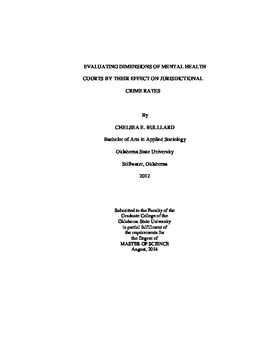| dc.contributor.advisor | Thrasher, Ronald R. | |
| dc.contributor.author | Bullard, Chelsea Elizabeth | |
| dc.date.accessioned | 2015-06-17T20:05:03Z | |
| dc.date.available | 2015-06-17T20:05:03Z | |
| dc.date.issued | 2014-08-01 | |
| dc.identifier.uri | https://hdl.handle.net/11244/14744 | |
| dc.description.abstract | Mental health courts are a relatively new phenomenon with limited research or validation of essential elements. This research uses a mixed-methods approach to evaluate dimensions of mental health courts based on their effects on jurisdictional crime rates in eleven Oklahoma mental health courts. I first divided the courts into two categories: more successful courts and less successful courts. More successful courts showed a statistically significant decrease in jurisdictional crime rate three years preceding and three years subsequent the year of each court's implementation; less successful courts did not. Then through non-participant observation of court proceedings, in-depth interviews of court team members, and historical document analysis, the research process uncovered variances between more and less successful courts. Results showed more successful courts prioritized monitoring methods like ankle monitors, home visits, probation staff, and frequent random drug testing. More successful courts provided multiple specially-tailored treatment options, transportation provisions, documents of requirements, mentor programs, and court-associated aftercare. Diversely represented court team members collaborated with other court programs to provide proper initial assessments. More successful courts used tangible symbolic incentives personalized to each court and individuals. Last, court dockets visibly divided their non-compliant and compliant participants. Found differences between more successful and less successful courts validate the use of jurisdictional crime rate in determining success. Some of the indicated successful practices adhere to the Essential Elements of a Mental Health Court and Beccaria's Essay on Crimes and Punishment. Identified more successful court theories may determine future best practices. | |
| dc.format | application/pdf | |
| dc.language | en_US | |
| dc.publisher | Oklahoma State University | |
| dc.rights | Copyright is held by the author who has granted the Oklahoma State University Library the non-exclusive right to share this material in its institutional repository. Contact Digital Library Services at lib-dls@okstate.edu or 405-744-9161 for the permission policy on the use, reproduction or distribution of this material. | |
| dc.title | Evaluating Dimensions of Mental Health Courts by Their Effect on Jurisdictional Crime Rates | |
| dc.type | text | |
| dc.contributor.committeeMember | Allen, Robert W. | |
| dc.contributor.committeeMember | Leffingwell, Thad | |
| osu.filename | Bullard_okstate_0664M_13464.pdf | |
| osu.accesstype | Open Access | |
| dc.description.department | Forensic Sciences | |
| dc.type.genre | Thesis | |
| dc.subject.keywords | anna mcbride court | |
| dc.subject.keywords | evaluation | |
| dc.subject.keywords | mental health court | |
| dc.subject.keywords | problem solving | |
| dc.subject.keywords | specialty court | |
| dc.subject.keywords | therapeutic jurisprudence | |
